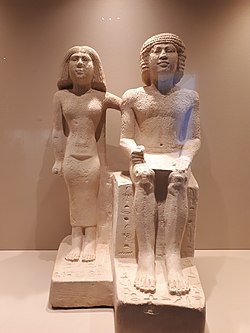Group of statues of Imhotep and Anchhathor
| Group of statues of Imhotep and Anchhathor | |
|---|---|
 Limestone statue group Imhotep and his wife Anchhathor
|
|
| material | limestone |
| Dimensions | H. 63 cm; W. 39 cm; D. 36.5 cm; |
| origin | Giza , necropolis |
| time | Old Kingdom , middle of the 5th Dynasty , around 2400 BC Chr. |
| place | Hildesheim , Roemer and Pelizaeus Museum , PM 1 |
The group of statues of Imhotep and Anchhathor from the Old Kingdom , middle of the 5th Dynasty , around 2400 BC. BC belongs to the Egyptian collection of the Roemer and Pelizaeus Museum Hildesheim , along with numerous other groups of statues from the Old Kingdom . The burial master, titled “Assistant to the royal leather workers”, was the representative of the king's affairs and is shown together with his wife.
Location
The Hildesheim merchant Wilhelm Pelizaeus financed several excavations by the Egyptologist Georg Steindorff from the University of Leipzig in the necropolis of Giza at the foot of the pyramid of King Cheops . During the excavation in 1903, the group of statues of Imhotep and Anchhathor by Georg Steindorff and Otto Völz was discovered in the Serdab (ie statue chamber ) of the brick mastaba D215 on the so-called Westfriedhof there. As part of the division of the find , it first came to the private collection of Wilhelm Pelizaeus in Cairo . In 1907 he handed over part of this collection to his hometown Hildesheim , so that it has been available to visitors there since the Wilhelm Pelizaeus Museum opened in 1911.
Description and state of preservation
The group of statues is made of limestone . It is 63 cm high, 39 cm wide and 36.5 cm deep. The combination of both figures corresponds to a standard common for the Old Reich . Imhotep is sitting on a cubic stool that is slightly sloping towards the front. The base on which his seat stands is also sloping towards the front. He wears the ear-covering curly wig typical of the time of the Old Kingdom . A belt holds his short, tight-fitting, smooth apron. His left hand is stretched out on his thigh and with the right hand he is holding a short cloth amulet. His wife Anchhathor stands to his right and is shown proportionally much smaller than her husband. Since Imhotep and Anchhathor have their heads at almost the same height despite their different postures, the group of statues looks very harmonious. Anchhathor stands with his feet closed on his own, also slightly sloping forward base. Her neck-high back pillar is connected to the back of her husband's seat. She embraces her husband with her left arm, with her hand resting on his shoulder. The space below her arm and between the two upper bodies is freely designed, a rare representation at this time. In all other spaces, however, connecting bridges have been left and painted black, which was to be interpreted as “empty space”.
The dress of the Anchhathor is tight-fitting and reaches half the length of the calf. The end of the dress on the upper body is no longer recognizable. Apparently it was just painted on. She wears a shoulder-length wig that is parted in the middle. The beginning of her own hair, also parted in the middle, can still be seen above her forehead. Imhotep's name and title can be read on the front of the seat and his wife's on the top of the plinth. Imhotep was employed in the palace as a commissioner for the king's affairs, "assistant to the royal leather workers" . His "beloved wife" bears the simplest title for a woman, "Miteret". In her right hand she also holds a short cloth amulet. This representation is rare for a woman of this time. While Günther Roeder recognized Imhotep as a stonemason , the term leather worker goes back to Hermann Junker.
The group of statues is relatively well preserved. However, small pieces of the man's upper arm, shoulder and left wig that were not found during the excavation are missing. The bridge of his nose is slightly damaged and four fingers on his left hand are missing. Anchhathor shows minor damage to the left side of her nose and mouth. When the group of statues was found, the limestone surface was already porous . This is especially noticeable on the torso, faces and wigs. In order to loosen sand deposits and salt efflorescence in the limestone, the group of statues was watered from September 1965 to June 1966. Unfortunately, the remains of the painting were washed out. Cracks in the face of the Anchhathor and a deep hole in Imhotep's apron were then repaired with stucco .
literature
- Albert Ippel , Günther Roeder: The monuments of the Pelizaeus Museum in Hildesheim . Curtius Verlag, Berlin 1921, pp. 50, 53
- Hans Kayser : The Egyptian antiquities in the Roemer-Pelizaeus-Museum in Hildesheim . Verlag Gerstenberg, Hildesheim 1973, ISBN 3-8067-8002-1 , p. 46.
- Regine Schulz : AR 13 group of statues of II-em-hetep and the Ankh-Hator. In: Arne Eggebrecht , (Ed.): Das Alte Reich, Roemer- und Pelizaeus-Museum, publisher, Verlag von Zabern Mainz, catalog 1986, ISBN 3-8053-0936-8
- Martin von Falck: 17 group of statues of the leather worker II-Em-Hetep and the Ankh-Hator. In: Ancient Egypt in Hildesheim. Volume 1: The Old Reich. Egypt from the beginnings to high culture , Verlag von Zabern, Mainz 2009, ISBN 978-3-8053-4073-1
- Eva Martin-Pardey: Sculpture of the Old Kingdom I (Corpus Antiquitatum Aegyptiacarum. Loose-leaf catalog of Egyptian antiquities. Pelizaeus Museum Hildesheim. Delivery 1 ). Verlag von Zabern, Mainz 1977, ISBN 3-8053-0291-6 , pp. 1-8
Web links
- http://www.globalegyptianmuseum.org/record.aspx?id=10376
- http://www.giza-projekt.org/Mastaba/Mastaba.html
See also
Individual evidence
- ^ Roemer and Pelizaeus Museum Hildesheim: Inventory number PM 1